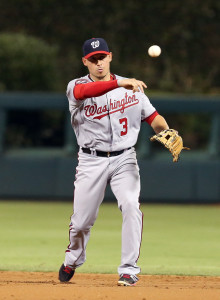It’s often dangerous to read too much into a hot streak, as the endpoints of the streak will often be arbitrary, and shrinking the sample size makes the data more susceptible to randomness. Though it’s dangerous to use them as a predictive tool, hot streaks can hold some significance for upcoming free agents — particularly ones that have struggled for much of the season. A well-timed hot streak can take a player’s numbers from good to great or from terrible to passable. A huge second half following a disastrous first half can demonstrate that a player hasn’t suddenly lost all of his skill, giving offseason suitors hope for more consistent production in the season(s) to follow.
The overall numbers on the following players may not quite look appealing, but here are three that could be in the midst of bolstering their offseason earning power after dreadful starts to the year (coincidentally — they’re all shortstops!)…
- Ian Desmond, Nationals: Perhaps no player looked to be costing himself as much money as Desmond entering the All-Star break. Heading into his contract season, there was a legitimate case to be made for Desmond as the game’s most productive shortstop over the past three seasons, but he slumped to a .211/.255/.334 batting line in the first half and endured an awful error-prone stretch in the field early on. He’s tightened up the errors after those first few weeks, though, and is finally showing signs of life at the plate. Over his past 21 games, Desmond is hitting .312/.376/.636 with seven homers and four steals. The question for him will become whether or not a huge second half can make his first half simply look like an anomaly and convince a team to invest more than $100MM.
- Asdrubal Cabrera, Rays: Cabrera settled for a one-year deal this winter, and through the first eight to 10 weeks of the season, he looked like a player that didn’t deserve anything more. However, since mid-June, Cabrera’s hitting .357/.393/.579 with four homers, 13 doubles and a triple. It’s easy enough to see that his .418 BABIP in that stretch is inflating his numbers, but there’s been some improvement as well. Cabrera struck out at a 23.1 percent clip through June 18, but since that night he’s at a more palatable 18.4 percent. He’s also hitting the ball with more authority, as evidenced not only by his spike in power but by his decrease in soft contact and increase in medium and hard contact (per Fangraphs). Surprisingly, Cabrera grades out as a plus defender at shortstop in 2015 as well, though it may take more than a few hundred innings to overturn his previous reputation as a poor defender. At the very least, he’s positioning himself to land the multi-year deal that eluded him this past winter.
- Jimmy Rollins, Dodgers: Suffice it to say, the 2015 season hasn’t gone as the Dodgers or Rollins had hoped. In his first season sans Phillies pinstripes, Rollins has flirted with the Mendoza Line and carried a sub-.600 OPS for much of the year. His current line is about 20 percent worse than the league-average hitter (80 wRC+, 78 OPS+), but a good deal of his struggles have also been BABIP-related, and his fortunes have begun to turn. Dating back to July 1, Rollins is hitting a much-improved .256/.315/.453, including hits in 15 of his past 18 games. Though his steals are well down, he’s already sporting a double-digit home run total. Rollins has not drawn strong ratings on his defense this year, but he does have a lengthy track record of high-quality glove work on which he can fall back. If he can continue his late surge at the plate and continue to make the first half look more like a blip, he should draw plenty of interest from teams looking for a sturdy veteran option up the middle.
- Alexei Ramirez, White Sox: Not long ago, Ramirez’s $10MM club option looked like a no-brainer to be bought out. Glancing at his overall numbers, that’d still be the case, but like the others on this list, he’s looked like a different player over the past month-plus. Ramirez was hitting .212/.235/.281 on June 30, but he’s hitting .291/.321/.480 with five homers and six steals in 34 games since. He’s not walking much (4.4%), but he’s also not striking out (7.4%), so his solid production comes with a very sustainable .283 BABIP. Ramirez can’t erase his ugly numbers through June 30, but if he sustains this production through season’s end, the White Sox or another team could easily be convinced that a .234 average on balls in play was responsible for his poor first half than a total collapse of his skill set.
Clearly, these four can’t all sustain their recent production (especially in the case of Desmond and Cabrera). However, it’s worth keeping an eye on each player’s production over the final seven weeks of the season, as none of the four looks as lost as he did even six weeks ago. In Desmond’s case in particular, that could mean the difference of tens of millions of dollars.
